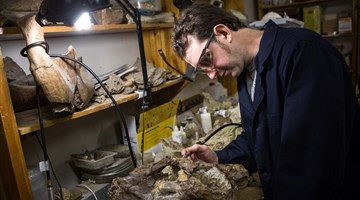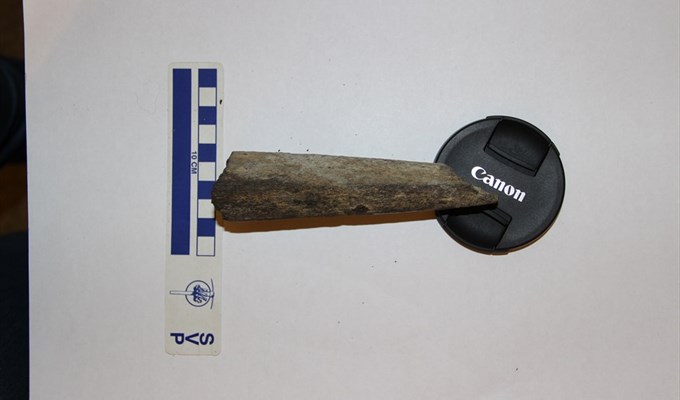TOMSK, Sep 12 – RIA Tomsk.
Expedition in which scientists of Tomsk State University (TSU) participated,
found remains of "tiny" dinosaurs, river turtles, primitive mammals
and ancient relatives of lizards in the remote Siberian taiga. The TSU
paleontologist Stepan Ivantsov told about the one who lived in Siberia 100
million years ago and what is known about these animals.
Neither by plane, nor by car
At the time of dinosaurs neither the
Krasnoyarsk taiga, nor the Krasnoyarsk Krai, nor the modern river Bolshoy
Kemchug, of course, existed. And now there is steep ravine on the river coast
where the scientists found a set of the remains of ancient animals, and a dense
taiga because of which it is impossible to reach it by the car (there are no
roads), by air (there is no platform where the helicopter could land).
"There is only one option – kayaks. This
time the place of works is points under the name "BK-4" – we have
reached record-breaking quickly, in three days", – Ivantsov told.
Total length of the route of alloy is about 200
kilometers, the place, which is interesting for the scientists, is
approximately in the middle. It is the ravine (abrupt high site of the coast)
about one kilometer long. Paleontologists managed to survey only a few meters
of break because it was necessary to work very carefully.
"Burial conditions are very interesting:
the bone-bearing lens is almost at the edge of water and before we arrived to
the place, we were afraid that it will be flooded. The second interesting
condition is the lens is extremely changeable on the level of concentration of
the remaining balance: constantly it was necessary to watch places with the
greatest number of the remaining balance", – the scientist specified.
www.youtube.comMovie "Paleo Exploration in the Delta of the Prehistoric River"
According to the paleontologists, refugium
formed somewhere in Siberia – the place in which some types of the Jurassic
Period (ended about 145 million years ago) remained also in cretaceous – that
is, existed on several million years longer, than all other in the planet.
One more similar territory was located,
according to the scientists, in the territory of modern Japan: finds of
paleontologists indicate that inhabitants of the Japanese and Siberian refugium
were very similar.
At the same time ancient animals lived not in
that place where the scientists found their bones. Bodies (or separate bones)
were brought by the huge ancient river. Millions of years the remains of
fossils were buried by the water stream which created a bone-bearing layer.
Dinosaurs
Ivantsov tells: the remains only of small
predators came across. According to them, dinosaurs were no more than 1,5
meters in length together with a tail.
"So far it is unclear what it is connected
with. Perhaps, there was some kind of "kindergarten" – the territory
where process of reproduction of predators and the first stages of life of cubs
took place. On other hypothesis, teeth belong to "a small species", –
the scientist added.
© сайт ТГУ
The remains of a titanozavrid found by TSU scientists
But participants of the expedition managed to
find the remains of herbivorous dinosaurs, presumably, not opened earlier
species.
© с сайта ТГУ
Ivantsov explained that in last years thanks to
finds on river banks of Kia the Tomsk paleontologists have already opened one
species of dinosaurs – herbivorous zauropod from family titanosaurs. Having
begun work on article about the opening, the scientists found out that they
deal with the remains not of one, but two species of dinosaurs.
It was succeeded to find a new species on
distinctions in teeth, but prior to the expedition of this year the version
about the second type of zauropod was only a hypothesis. It will manage to be
confirmed or disproved thanks to the new found remains belonging to animals of
different age: from cubs to, perhaps, "old men".
"Teeth of earlier opened titanozavrid has
a spoon form with the surface of deleting at top. And other taxon has a
straighter crown and they are also slightly pointed. Possibly, the structure of
teeth reflects adaptation to a diet: they worked as garden scissors – the
animal broke plant material and swallowed it, without chewing", – Ivantsov
explained.
In his opinion, two species of herbivorous
dinosaurs could get on because they had different "diet": one could
eat vegetation from tops of trees, and others – a pasture. However to draw
conclusions on how unknown species of ancient pangolins looked earlier is
impossible, until elements of their skeleton aren't revealed.
© предоставлено пресс-службой ТГУ
Thorn of a stegozavr - a find of the TSU paleontologists
"Neighbors" of dinosaurs
Besides dinosaurs the paleontologists found
also their "neighbors" – other residents of prehistoric Siberia. For
example, they managed to collect material on turtles who lived in the ancient
river.
"The remains of the turtles were met
earlier, but material was very fragmentary. The Siberian turtles are now
considered to be the same species that earlier were found in Kyrgyzstan.
Perhaps, new finds will give us the chance to describe a new taxon", –
Ivantsov told.
Also the scientists were succeeded to find a
fragment of a jaw of an ancient lizard – "relative" of modern monitor
lizards who were settled worldwide and live even in Australia. Before the
remaining balance of such reptile was found only once on Bolshoy Kemchug and
therefore the type is studied not so well.
© РИА Томск. Павел Стефанский
The scientists hope that new finds will allow
to consider the Siberian lizards to be one of already known species of ancient
reptiles or to allocate a new species.
"We always try to track fauna of mammals.
It is a very big rarity: there are not a lot of places in the world where
the remains of mammals of the Mesozoic Era could be met. And the finds did not
disappoint us – we found three-four teeth a day, about 40 teeth and fragments
of jaws were brought together", – Ivantsov added.
The paleontologist specified that a part of the
found teeth and bones is, most likely, the remains of amfilitsid – the
primitive mammals, specific for the Jurassic Period, who have no modern
descendants. However, scientists don't exclude an opportunity that also more
"advanced" animals lived in Siberia.
Amfilestida are still too similar on reptiles –
perhaps, they even laid eggs, as well as their reptiliyny ancestors.
"The proximity to reptiles is expressed, for
example, in teeth. They stand out a gum for only 1,5-2 millimeters. Tooth has
several sharp tops and big roots. Such teeth of an amfilestida could not chew,
but bite off. Most likely, they were insectivorous", – the interlocutor of
the agency explains.
According to Ivantsov to draw
more concrete conclusions, the scientists need to continue work and to
investigate finds in vitro.